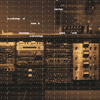An Anthology of Noise & Electronic Music/Sixth, A Chronology 1957-2010
 Apparently the penultimate installment in the long-running series of compilations from Sub Rosa, this volume continues the tradition of putting some of the bigger names (Z'ev, Stephen O’Malley) with some newer and up and coming artists (Torturing Nurse, Robert Piotrowicz), but this time with a seemingly stronger bent towards contemporary "noise," which is a good thing.
Apparently the penultimate installment in the long-running series of compilations from Sub Rosa, this volume continues the tradition of putting some of the bigger names (Z'ev, Stephen O’Malley) with some newer and up and coming artists (Torturing Nurse, Robert Piotrowicz), but this time with a seemingly stronger bent towards contemporary "noise," which is a good thing.
While the "bigger names" from the Japanese noise scene, such as Merzbow and Masonna have already been represented in these compilations, there sits nicely towards the end of the first disc a block of tracks that will make any fan of the genre giddy.The segment begins with an early track from Kohei Gomi, better known as Pain Jerk.Recorded in 1993, "Aufheben" demonstrates that even at this early stage he was defining his sound through jerky, quick cuts and edits, but the penchant for rhythmic loops he later refined isn't quite in place yet.The double dose of Hijokaidan and the Incapacitants back to back made me quite happy, and reminded me of that sequencing of the two bands on the classic Japanese/American Noise Treaty, which is what attracted me to the genre some 15 years ago.The Hijokaidan track "Untitled" is from 1994 and clocks in at nearly 12 minutes and captures the core trio in their prime:T. Mikawa's shrill, enveloping electronic noise, Jojo Hiroshige's abused guitar squall, and Junko’s intentionally abrasive screams.Unlike their traditional "harsh noise wall" approach, there’s some variation and almost rhythms to be found here.
Mikawa and co-conspirator Fumio Kosakai follow that up with the Incapacitants' "Shall We Die?" from 1990, a slightly more restrained sound from them of lost shortwave radio static and buzzing oscillator leads.While at first it sounds like a frozen wall of noise, a closer inspection reveals a microcosm of sound and activity at work.It sounds exactly like the Incapacitants, and any good fan would be annoyed if it didn't.Rounding out the dose of harshness is the newer Chinese band Torturing Nurse, who delivers a dynamic, violent collage of feedback and overdriven tones that definitely sounds influenced by the Japanese masters with "Yes or No", but with a feeling all their own.As if to reinforce the point that not all electronic music from Asia is raw noise, Sachiko M’s "2808200" ends the subset of tracks with a sterile, minimal study of test tones via sampler, resulting in a sparse, yet compelling piece that is the polar opposite of what preceded it.
A briefer study of the American noise artists opens the second disc, first with a 1980 performance by Z'ev, a battering sprawl of metal percussion and the decay of industrial civilization that sounds as fresh today as it did 30 years ago. The Daniel Menche piece "Fulmination" comes from unknown sources, but is a slow, dark trudging work of maxed out bass frequencies and a subtle, rhythmic thump that eventually transforms into what sounds like trains or mechanical crashes in a piece that takes its time in its slow development and structural variations.Contrasting Menche's 12 minute mediation, John Wiese contributes a 2 minute blast of punk noise in "New Wave Dust," full of abrasive laptop tones and jump edits that strongly display the more chaotic, unpredictable flavor of noise.
John Duncan's "The Nazca Transmissions #2" is a glassy, creepy pastiche of sound that, whether or not sourced from the actual Nazca lines in Peru and then summarily cursed in their production (according to the liner notes), has a disturbing otherwordly quality that speaks for itself.Stephen O'Malley’s "Dolmens & Lighthouses" unsurprisingly piles on the low frequencies, but is a tonal, minimalist digital composition of haunting sounds that feels connected conceptually to Sunn O))), but has an identity all its own.Polish artist Robert Piotrowicz's "Lincoln Sea Ice Walk" uses his love of modular analog synths to sculpt a layered, dense wall of sound that is slow, but glorious in its development.
While this edition does stay closer to the noisier end of the spectrum, it by no means fully defines the set.Speedcore, the spastic descendant of gabber is represented by "Virus" courtesy of The Pain Barrier/Rico Schwantes.Keeping the 909 thump and AK-47 tempos of the genre but removing the techno and house music clichés and replacing them with more dissonant, abrasive textures goes a long way, resulting in a more refined listening experience that still thrashes.
The earlier artists are not as represented here, arguably because their work has been covered rather well in previous installments of this series.Henry Cowell's "The Banshee" predates many other studies in the avant garde of the piano, here from a 1957 recorded performance.The traditional sound of hammered strings is present, but the roaring reverberations and scraped strings overshadow the notes and strongly represent the titular terrifying spirit.Dick Raaymaker's "Piano-forte" from 1960 feels like the natural follow-up, but is an even further abstraction of the sounds of the piano, here cut up and spliced into disorienting, chaotic bursts of sound.
While it might be somewhat less diverse than the prior volumes of this series, the strength of the mostly exclusive noise pieces caused me to instantly fall in love with it.Coupled then with the lesser-known artists representing the other genres of electronic music, the result is a brilliant blend of the familiar and the new that puts this as probably my favorite installment thus far.
samples:
- Henry Cowell - "The Banshee"
- Hijokaidan - "Untitled"
- Stephen O'Malley - "Dolmens & Lighthouses"
 




